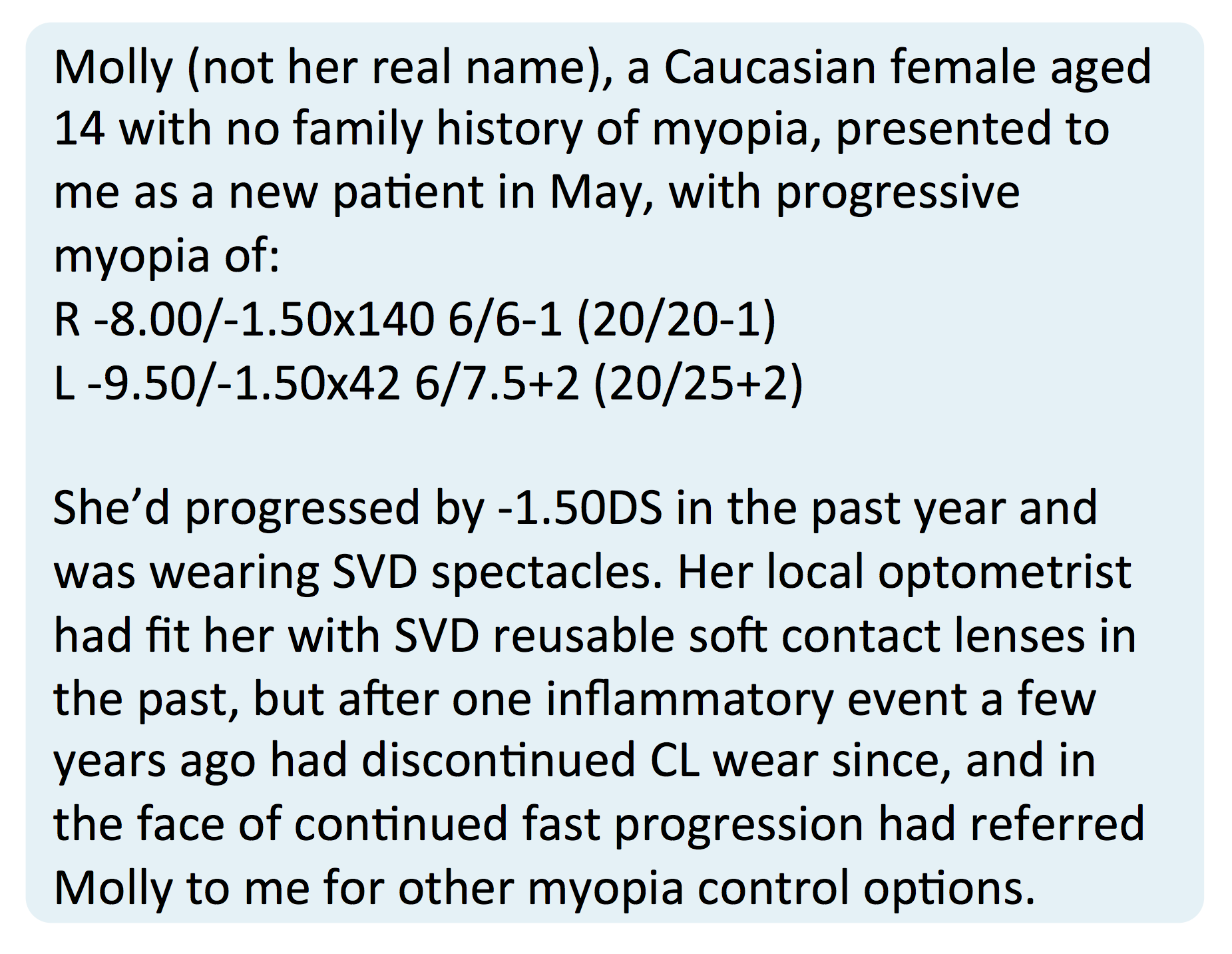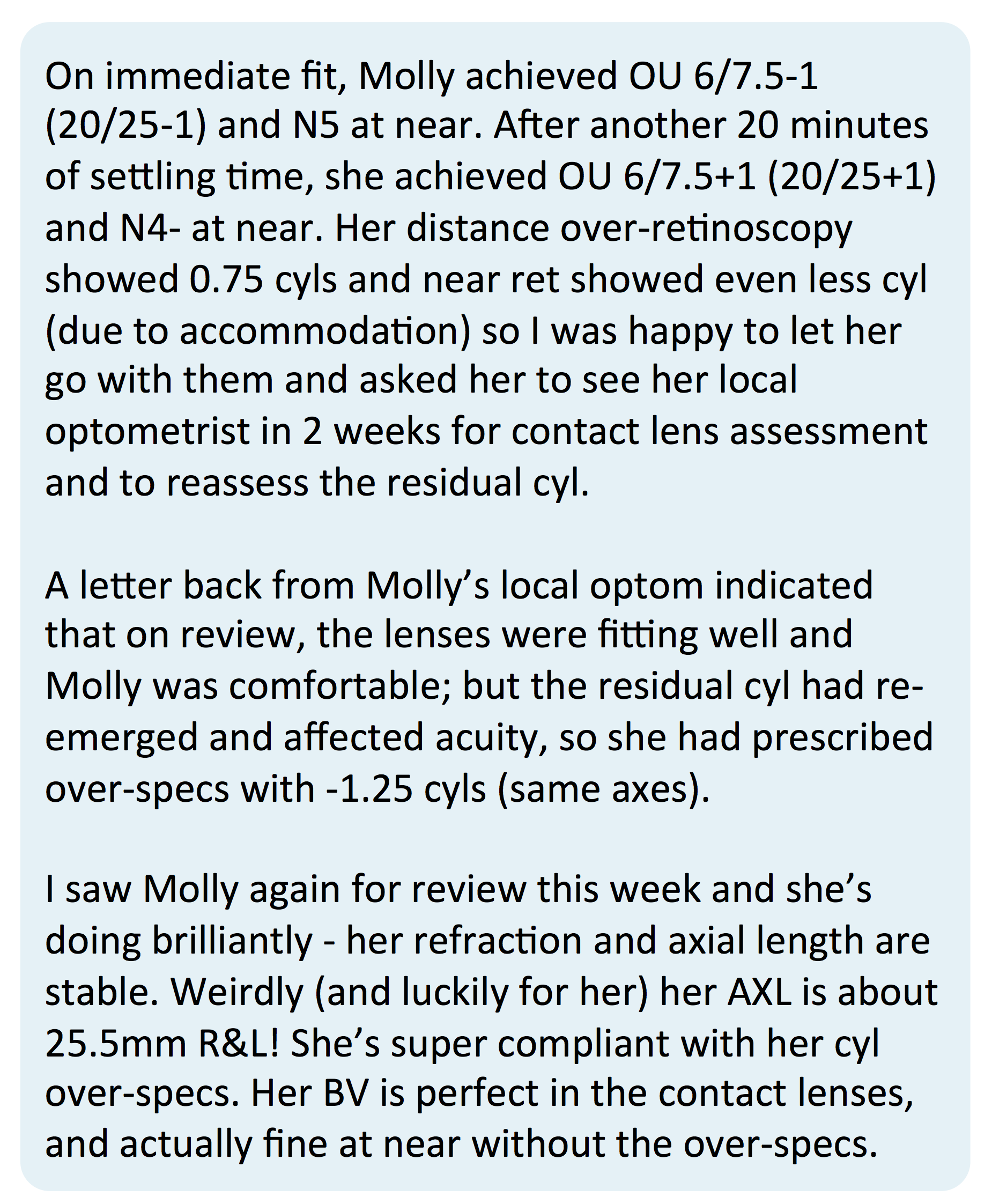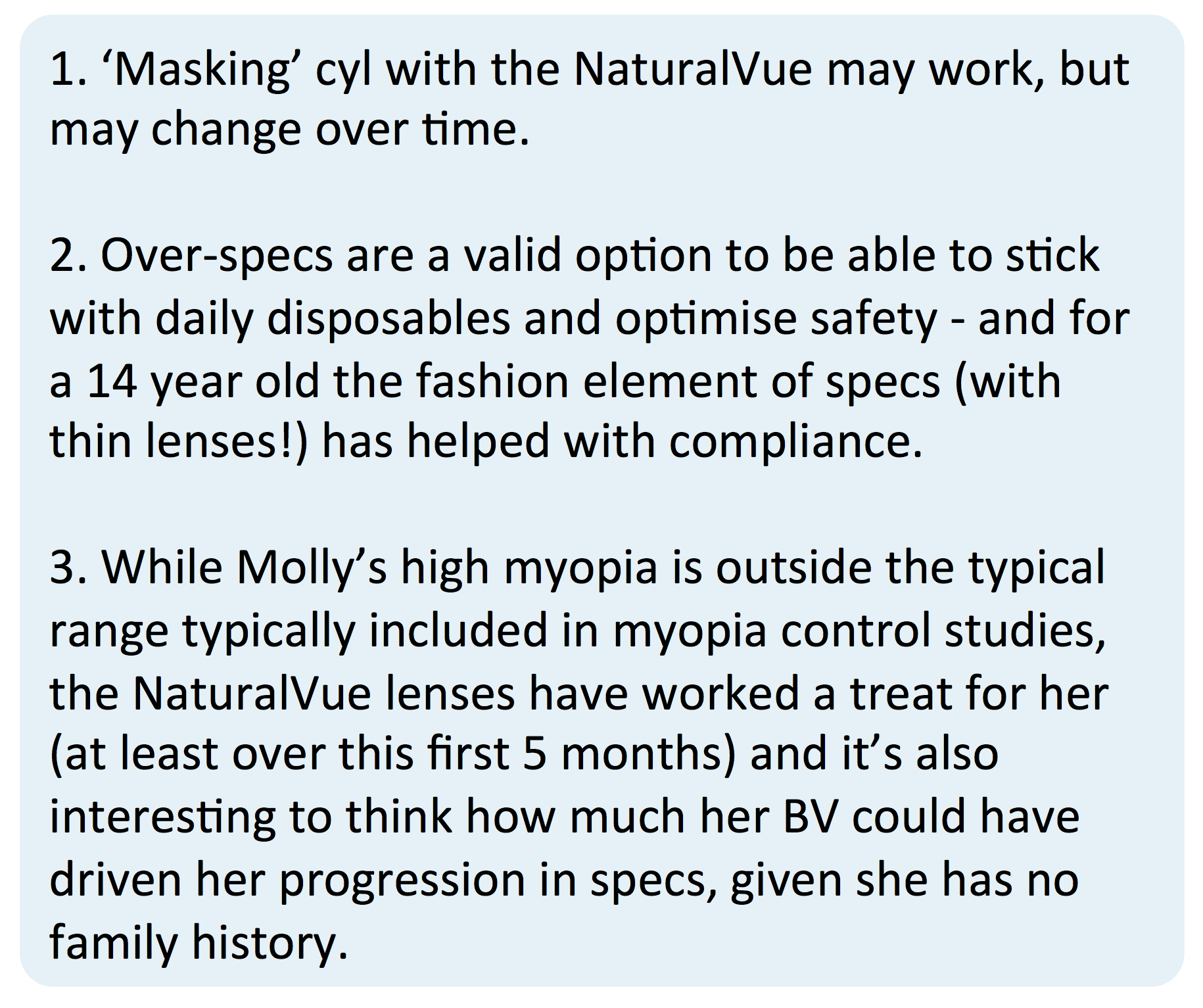The NaturalVue contact lens is a daily disposable soft multifocal lens for myopia control. The high safety profile of a daily disposable and wide power range available for the NaturalVue defines its role in the domain of myopia control options. Being an 'extended depth of focus' design, it is explained by its manufacturers Visioneering Technologies, Inc (VTI) to create a 'virtual pinhole aperture' with a wide range of simultaneous clear vision.
Typically spherical contact lenses (multifocal or not) are indicated only for low levels of astigmatism, and indeed the NaturalVue fitting guide advocates selecting patients with no more than 1D of astigmatism. This is ideal for first fit success. The more extensively detailed NaturalVue Professional Fitting and Information Guide, though, states that "The [multifocal] lenses may be worn by persons who exhibit astigmatism of 2.00 diopters or less that does not interfere with visual acuity."
This potential for correcting higher levels of astigmatism than is typical in spherical multifocal CLs is likely due to the unique optics of the NaturalVue lens, where the 'pinhole optics' may be partially correcting rather than masking astigmatism.
KG shared an interesting case study with the Myopia Profile Facebook community about managing astigmatism with NaturalVue lenses, and also how binocular vision can alter in contact lens fitting. We’ve broken KG’s case study into a few parts. Let's start with the patient's profile.

Molly has high myopia and is a fast myopia progressor when compared with the average which is 0.59D per year.1 Being a teenager also would lead one to expect slower rates of myopia progression. Hence, some form of myopia control treatment is definitely warranted.
High myopes are best in contact lenses

Given the degree of her myopia, contact lenses would be an ideal form of optical correction as the magnification of the retinal image by contact lenses can help improve acuity. When it comes to myopia control, Molly's prescription is outside of the range of typical myopia control studies which usually include myopes up to 5-6D. The NaturalVue case series analysis, from which its myopia control efficacy was indicated, did include one participant of -8 and one of -10.2 In the absence of more volume of data on higher myopes, though, 'typical' result cannot be expected and so both Molly and her parents should be advised that while there is no data on myopia control in such a high level of myopia, there is opportunity to try with an intervention which in all likelihood will provide better myopia control than a single vision correction.2
Due to a past contact lens-related inflammatory event when wearing reusable soft contact lenses (CLs), ensuring safety is of the utmost importance to Molly's confidence as a contact lens wearer, as well as confidence for her parents and practitioner. Hence, daily disposable CLs are the ideal choice due to their lower risk of infection or complication compared to reusable CLs.3
Initial contact lens fitting

At the initial fitting, Molly had relatively good vision and a low astigmatic over-refraction, which suggests that she could potentially rely on these contact lenses alone for optical correction. However, this changed over time and at the contact lens aftercare, she showed residual astigmatism and required over-specs to improve her visual acuity.
Surprisingly, her axial length ('AXL') was not as long as could be expected for her level of myopia - where 26mm is on average associated with around 5D of myopia.4
A lower axial length is very good news for Molly as the lifetime risk for vision impairment associated with myopia increases significantly for eyes longer than 26mm.4 This reinforces the value of having axial length data to evaluate eye health risk in myopia.
Were the correct trial lenses selected?
The NaturalVue Multifocal fitting guide includes the QuickStart Calculator which encourages practitioners to refract 'one step into the green' on Duochrome, and then enter this sphero-cylindrical refraction into the calculator to allow correction for vertex distance and trial lens selection.
KG cites starting with trial lenses of R (OD) -7.00 and L (OS) -8.00, which reflects vertex corrected power for the sphere component of Molly's refraction only. Entering Molly's full sphero-cylindrical refraction into the QuickStart Calculator results in suggested first fit lenses of R (OD) -8.00 and L (OS) -8.75. Perhaps the additional minus power in the trial lenses could have resulted in a different outcome regarding the astigmatism. Then again, perhaps Molly's oblique astigmatism may have needed full correction regardless, given that uncorrected oblique astigmatism can impact acuity more than at other meridians.5
Molly’s binocular vision (BV) status

An unusual aspect of this case is that Molly is a very high myope with no family history of myopia, and of an ethnicity typically associated with lower levels of myopia.6
The state of her binocular vision with spectacle correction could potentially be the answer. Having spent most of her time in single vision spectacle lens correction, the high amounts of esophoria and accommodative lag could potentially have contributed to her fast myopia progression. Read more about this in Four reasons why binocular vision matters in myopia management.
Aside from myopia correction and the potential for myopia control, a third benefit of Molly wearing CLs is the effect on her BV. Typically, myopes changing from spectacles to contact lenses will exhibit an exophoric shift, which is ideal for an esophore. This effect has been demonstrated in single vision corrections, and is typically greater for higher levels of myopia. Read more about this in our blog Specs to contact lenses - what happens to binocular vision? In addition to this expected response, one research abstract has indicated that the NaturalVue multifocal may create a small additional exophoric shift compared to a single vision contact lens.
Take home messages:
This case illustrates the interesting challenges of managing patients outside of the typical realm of myopia control - in this case a high myope. It also highlights the dynamics of the visual system, and also raises the point about following fitting guides to achieve best possible outcomes. KG has succinctly summarised the main take home messages below, although keep in mind that 'masking' astigmatism is more correctly expressed as 'partially correcting' with the NaturalVue multifocal contact lens.


About Kimberley
Kimberley Ngu is a clinical optometrist from Perth, Australia, with experience in patient education programs, having practiced in both Australia and Singapore.

About Connie
Connie Gan is a clinical optometrist from Kedah, Malaysia, who provides comprehensive vision care for children and runs the myopia management service in her clinical practice.
This content is brought to you thanks to an unrestricted educational grant from

References
- Saw SM, Nieto FJ, Katz J, Schein OD, Levy B, Chew SJ. Factors related to the progression of myopia in Singaporean children. Optom Vis Sci 2000;77(10):549-54. (link)
- Cooper J, O'Connor B, Watanabe R. Case series analysis of myopic progression control with a unique extended depth of focus multifocal contact lens. Eye Contact Lens 2018;44:e16-e24. (link)
- Stapleton F. Contact lens‐related corneal infection in Australia. Clin Exp Optom. 2020;103(4):408-17. 9 (link)
- Tideman JW, Snabel MC, Tedja MS, et al. Association of Axial Length With Risk of Uncorrectable Visual Impairment for Europeans With Myopia. JAMA Ophthalmol. 2016;134(12):1355-1363. (link)
- Wolffsohn JS, Bhogal G, Shah S. Effect of uncorrected astigmatism on vision. J Cataract Refract Surg. 2011 Mar;37(3):454-60. (link)
- French AN, Morgan IG, Burlutsky G, Mitchell P, Rose KA. Prevalence and 5- to 6-year incidence and progression of myopia and hyperopia in Australian schoolchildren. Ophthalmol. 2013;120(7):1482-91. (link)











